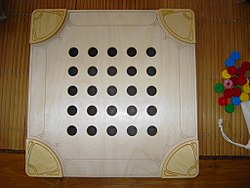Push (game)
| Push | |
|---|---|
 The game board from Push |
|
| Game data | |
| author | Steffen Mühlhäuser |
| publishing company | Steffen Games |
| Publishing year | 2001 |
| Art | Board game , game of skill |
| Teammates | 2 to 4 |
| Duration | 10-30 minutes |
| Age | from 8 years |
Push is a board game that is all about skill and a little bit of strategy. The origin has not been proven, according to the manufacturer it is said to be an old game from India, which flourished briefly in Scotland and then disappeared again.
There is broad agreement among the push players about the rules, but regional peculiarities can be determined.
Game material
- 1 game board with holes
- 48 pieces - 12 each in one color
Goal of the game
Every player tries to sink as many stones as possible into the holes of the board , but certain positions or formations bring different points or penalty points, which makes the game not only a game of skill , but also to a limited extent a strategy game .
Game flow
It is 2 to 4 players turn clockwise, starting with the youngest player or the loser of the last round. The player may put three pieces into play one after the other . To do this, one stone is placed at any point on the firing line with the marking facing up and then pushed into the playing field by snapping the index or middle finger.
Sunk stones remain in place until the end of the game. Not sunk initially remain on the board. If game pieces slide directly onto the line of a launch zone or into the zone itself, they are removed directly from the board. If there are 4 stones of the same color on the board, they are immediately removed from the board. If a player has fewer than 4 stones at the end of the game, the stones are cleared when he has gambled away all of the remaining stones. Here, too, each player has three shots free, and if there is any remaining stone, the same stone is taken.
If an opponent's token is pushed off the board, the opponent may bring it back into play immediately, after which the game continues as before. If a player shoots his own stone from the board, his turn ends immediately.
The Viennese variant
- The beginner is determined by scissors, stone, paper , who can choose whether "unlimited" (the player remains on the move as long as he / she hits) or whether "limited" (usually 3 times one after the other) is played.
- The pieces are played regularly with the mark facing down. If the stone is sunk with the marking up, 3 points are added. Furthermore, if there are 3 loose stones, they are removed from the board. In addition, vertical, diagonal and horizontal rows of 4 count 4 extra points and crosses (orthogonal, made of 5 stones) count 5 extra points.
- In the Center Queen / King variant , the first shot is aimed at the central hole. If you hit, the game continues as usual. If the hole is missed, it may only be filled with the last piece and must complete a combination.
Playing
The game is over when a player has pocketed all 12 stones of his color or, if there are more than two players, all holes have been hit.
Rating
- There is one point for each piece in the row that is closest to the player. From the player in the second row there are two points, in the third row three, etc.
- Double points are awarded for individual stones if the stones are rotated while being pushed and are thus sunk into the hole with the marking pointing downwards.
- If a chain of four (line) is created horizontally to the player, this brings one additional point in the 1st row, two additional points in the 2nd row, etc.
- Horizontal or diagonal chains of four generally earn 3 additional points.
- A cross made from 5 pieces gives 3 additional points.
- If a 5-player chain (bad line) is created by one's own moves or by opposing players, there are two minus points.
- Overlapping formations are calculated individually, even if they overlap.
- The end result is the sum of the individual points and the formation points.
- The player with the most points wins the game.
Web links
- Push on the publisher's homepage
- Push in the Luding games database
- Push in the game database BoardGameGeek (English)